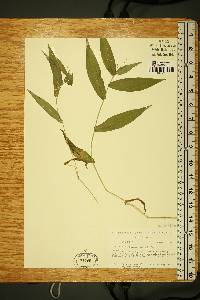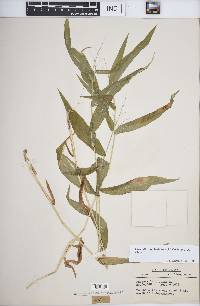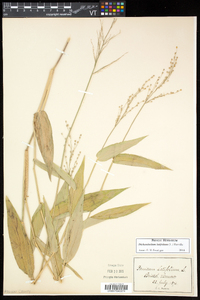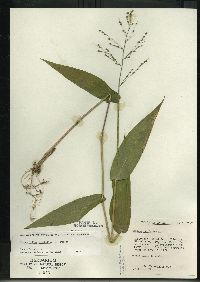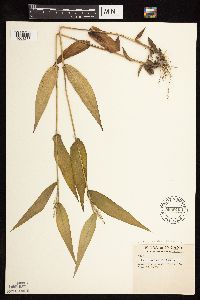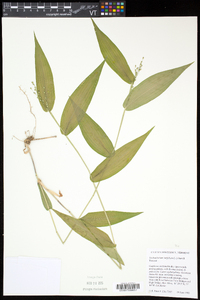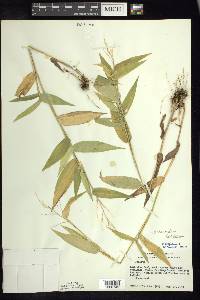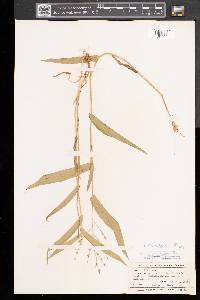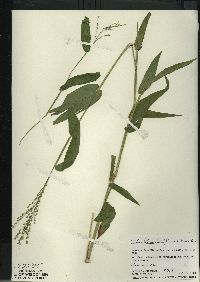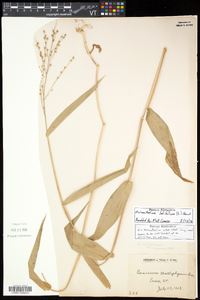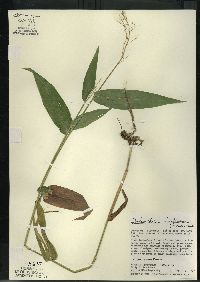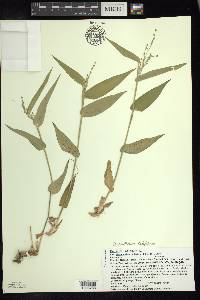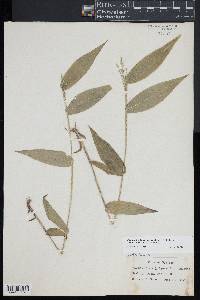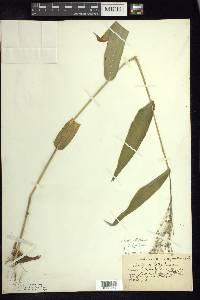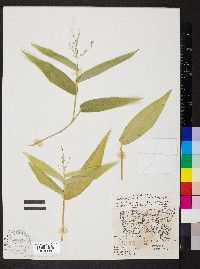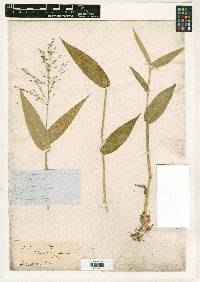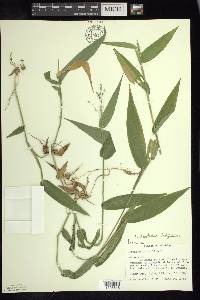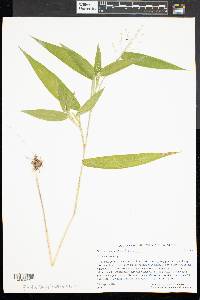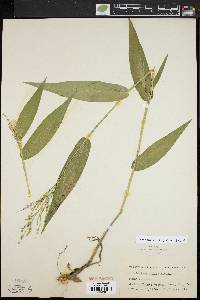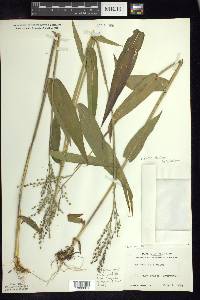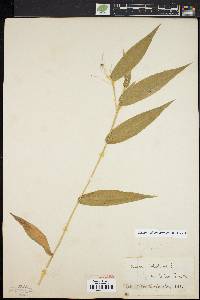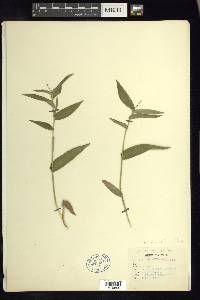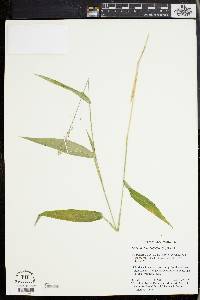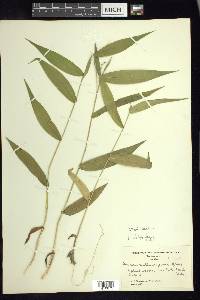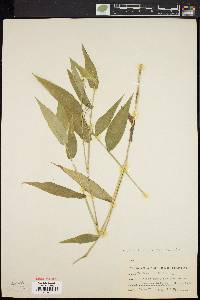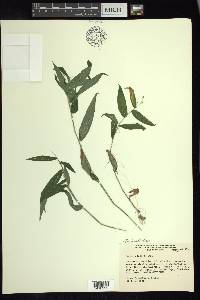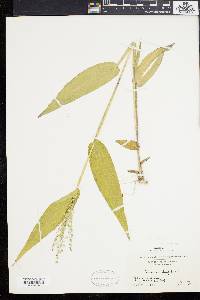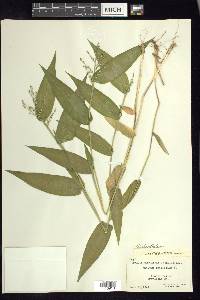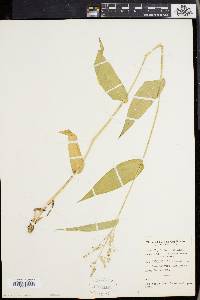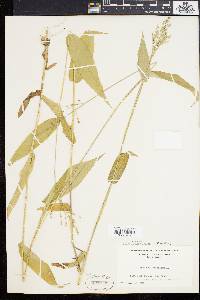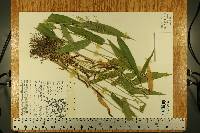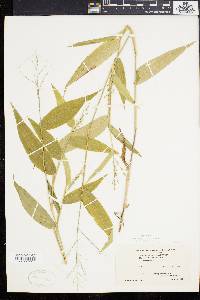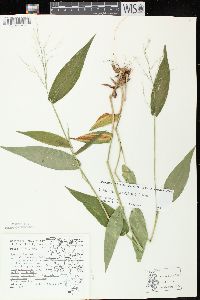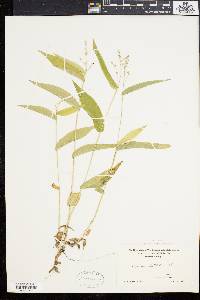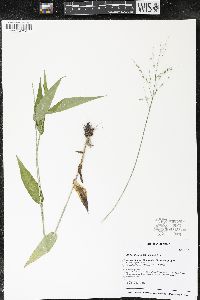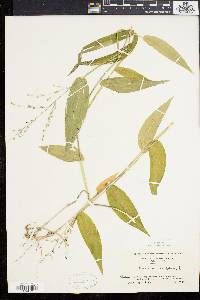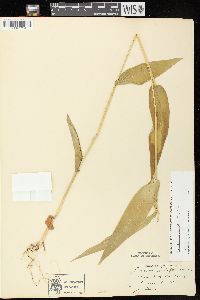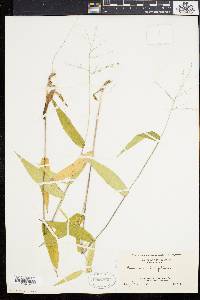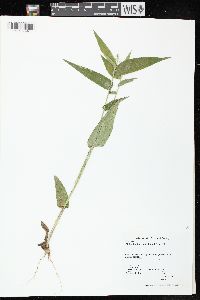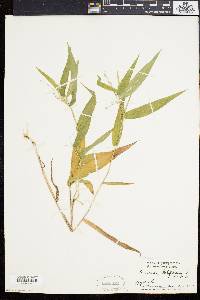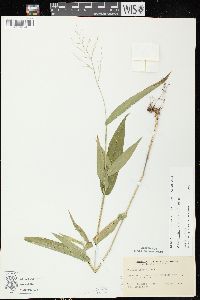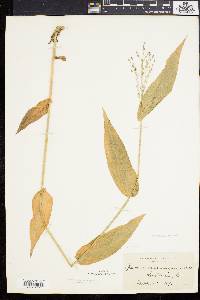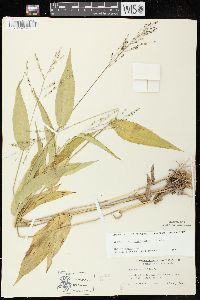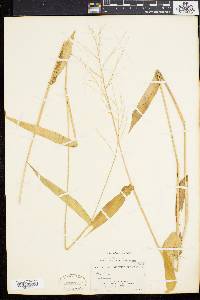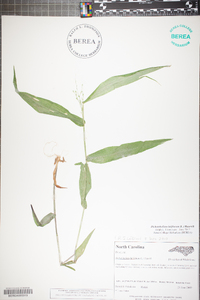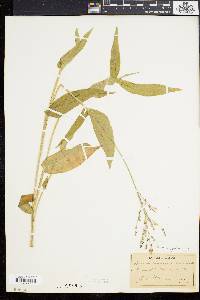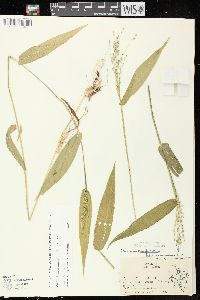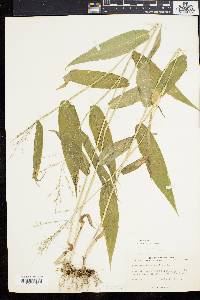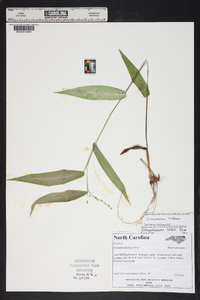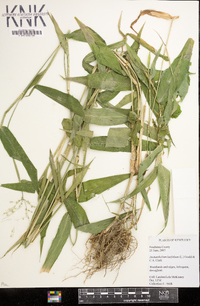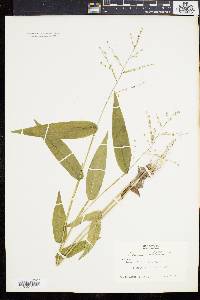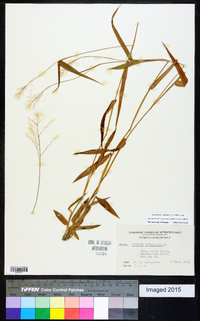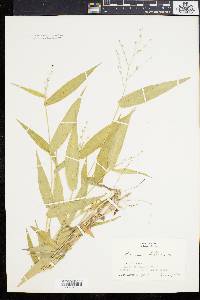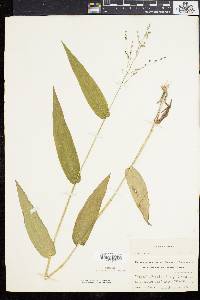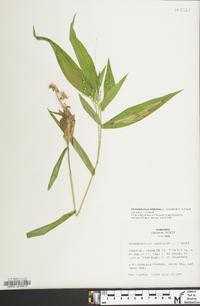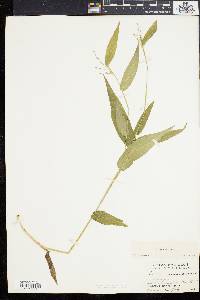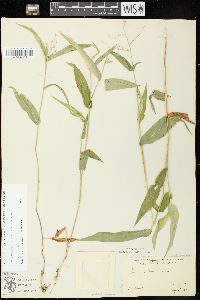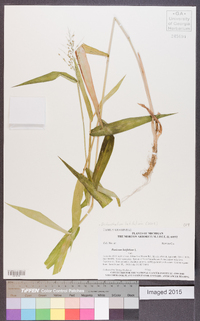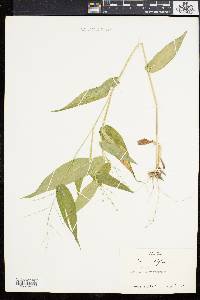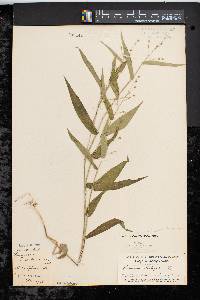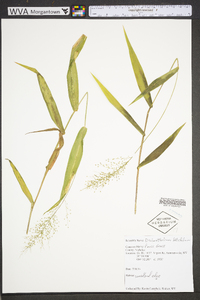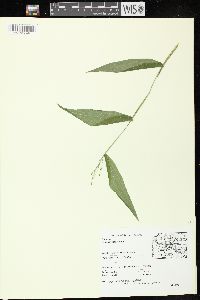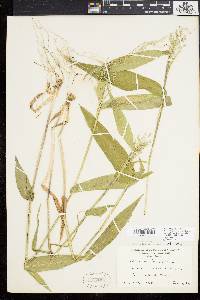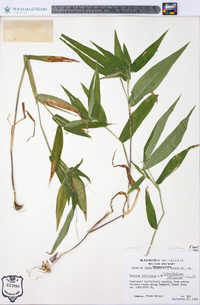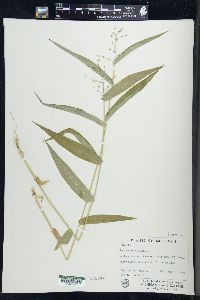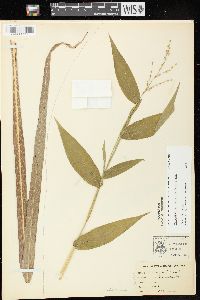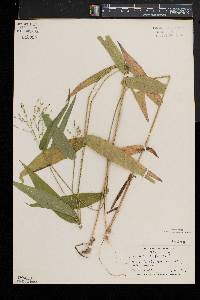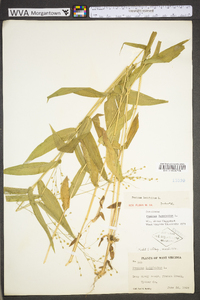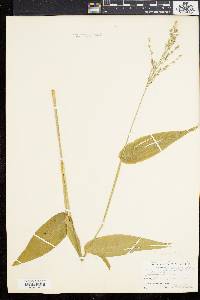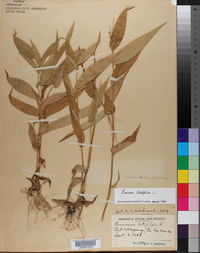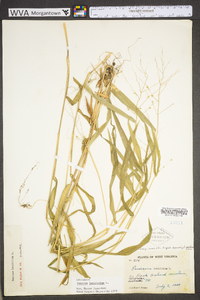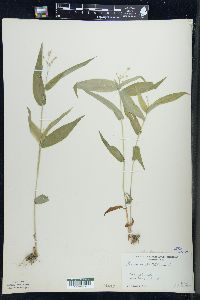Dichanthelium latifolium
|
|
|
|
Family: Poaceae
Broad-Leaf Witch Grass, more...broadleaved panicgrass, broadleaf rosette grass (fr: Panic à Larges Feuilles)
[Panicum schnecki Ashe] |
Plants forming small clumps, with knotty rhizomes less than 2 mm thick. Basal rosettes well-differentiated; sheaths pubescent; blades ovate to lanceolate, dark green. Culms 45-110 cm, nearly erect; nodes glabrous or the lower nodes slightly bearded; internodes glabrous or sparsely pubescent; fall phase branching from the midculm nodes, branches nearly erect, scarcely rebranching, blades and secondary panicles only slightly reduced. Cauline leaves 4-6, often with a transitional leaf above the basal rosette; sheaths not overlapping, glabrous or softly villous basally, margins ciliate, collars pubescent; ligules 0.4-0.7 mm, membranous, ciliate, cilia longer than the membranous portion; blades 3.7-7 times longer than wide, 15-40 mm wide, ovate-lanceolate, glabrous or sparsely pubescent, with 11-13 major veins and 40-120 minor veins, bases cordate-clasping, with papillose-based cilia. Primary panicles 7-15 cm long, 4-12 cm wide, 1.5-2 times as long as wide, with 20-80 spikelets, eventually at least partially exserted; branches stiff, ascending to spreading. Spikelets 2.9-3.9 mm long, 1.6-2 mm wide, ellipsoid, sparsely pubescent. Lower glumes 1/3-1/2 as long as the spikelets, narrowly triangular; upper glumes and lower lemmas slightly shorter than the spikelets, often red-tinged basally and apically; lower florets staminate, anthers exserted prior to those of the upper florets; upper florets pointed, apiculate, upper lemmas with a minute fringe of hairs. 2n = 18, 36. Dichanthelium latifolium grows in rich deciduous woods, often in slightly open areas within eastern North America. The primary panicles are open-pollinated and develop in May and June (and sometimes in September and October), the secondary panicles, which are producedfrom July through September, are rarely open-pollinated. Perennial herb with knotty rhizomes, forming small clumps 45 cm - 1 m tall Inflorescence: a terminal, branched arrangement of spikelets (panicle). Primary panicles atop the culms, 7 - 15 cm long, 4 - 12 cm wide, one and a half to two times as long as wide, becoming partially exserted, bearing twenty to eighty spikelets. Secondary panicles (when present) atop the branches. Fruit: a caryopsis, indehiscent, enclosed within the persistent lemma and palea. Culm: nearly upright, 45 cm - 1 m long, round in cross-section, hollow, sometimes sparsely hairy. Nodes sometimes slightly bearded on the lower nodes. Fall phase branching from mid-culm nodes, branches nearly upright, scarcely rebranching, producing only slightly reduced leaf blades and secondary panicles. Spikelets: 3 - 4 mm long, 1.5 - 2 mm wide, ellipsoid, sparsely hairy. Basal leaves: in a rosette. Sheaths hairy. Blades shortly egg-shaped to lance-shaped, distinct from stem blades. Stem leaves: four to six, alternate, two-ranked. Sheaths not overlapping, usually shorter than internodes, sometimes softly hairy basally, fringed with hairs. Ligules about 0.5 mm long, membranous, fringed with hairs (hairs longer than membranous area). Blades distinctly longer and narrower than basal leaves, four to seven times longer than wide, 1.5 - 4 cm wide, egg- lance-shaped with a clasping, heart-shaped base, many-veined, sometimes sparsely hairy, fringed with bumpy-based hairs. Glumes:: Lower glumes often reddish at the base and apex, one-third to one-half as long as spikelets, narrowly triangular. Upper glumes a bit shorter than spikelets, rounded to pointed at the apex. Lemmas:: Lower lemmas similar to upper glumes, often reddish at the base and apex, a bit shorter than spikelets. Upper lemmas longitudinally lined, shiny, with rolled-up margins above, fringed with minute hairs. Paleas:: Lower paleas shorter than lower lemmas, thin. Upper paleas longitudinally lined. Florets:: Lower florets male. Upper florets bisexual, stalkless, pointed, plump. Anthers three. Stigmas red. Similar species: No information at this time. Flowering: late May to mid-July Habitat and ecology: Common in moderately moist woodlands. Occurence in the Chicago region: native Etymology: Dichanthelium comes from the Greek words di, meaning twice, and anth, meaning flowering, referring to plants that may have two flowering periods. Latifolium means broad-leaved. Author: The Morton Arboretum From Flora of Indiana (1940) by Charles C. Deam Rather frequent in dry or moist white oak and black oak woods in the lake area. Infrequent to local in the southern part of the state where it is largely replaced by the next species which is absent in our northern counties. ...... Indiana Coefficient of Conservatism: C = 6 Wetland Indicator Status: FACU |


